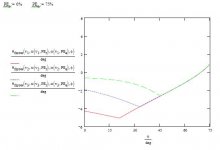Patrick Johnson said:
You have to hit the right OB contact point with spin just like you have to without spin. That point doesn't get any bigger because you've added spin...
But it
can get bigger, provided you add the right amount of outside spin for a particular cut shot angle.
Take a look at the graph below from
Dr. Dave's article that Jal has linked. The plot shows the amount of throw (y-axis, measured in degrees) versus cut angle (x-axis, measured in degrees) for a stun hit (PEr=0%) and a fair amount of outside english (PEe=75%). The red, blue, and green lines represent soft, medium, and firm shots, respectively.
The thing to note is where these lines cross the zero point on the y axis, which seems to be about 70 degrees. This indicates that for a 70-degree cut shot and for that particular amount of outside english (75% of "maximum"), then you would perfectly compensate for any CIT, and that the balls would roll across each other at the contact point, giving you absolutely zero throw. To the left of this point, the curve is negative, which indicates you're actually throwing the ball due to the overspin. To the right of this point, the curve is positive, which is the "bad" type of throw.
The thing to notice is the
slope of the lines to the left of the zero crossing point. Just looking at the medium-hit shot (blue line), between approximately a 32-degree cut and a 65-degree cut, the slope of the line is positive. This indicates the amount of "automatic correction" (Jal, I like that term) for that particular amount of outside english. The slope is about 1/7, which lines up with Jal's calculation...meaning that for every degree of cut angle error, the outside english compensates 1/7th of that amount.
In the ideal, zero-friction case, then the slope of the lines would all be zero, meaning no automatic correction. Any positive slope on the graph is "good", meaning there is auto correction (positive slope and negative throw would be the best combination). Any negative slope would be "bad", which means the more cut angle error you have, the throw error (or lack of throw) will add to the error, making the contact point even smaller than the zero-friction case (negative slope and positive throw would be the worst combination).
So it is true that the OB contact point in which you can pocket a shot can get bigger depending on the amount of english and the cut angle.
Patrick Johnson said:
...it just gets a little harder to figure exactly where it is (its location moves with more or less spin) and a little harder to hit it (because of squirt/swerve). Why make the shot harder?
But of course, this is true as well. Not only do you introduce squirt and swerve into the picture, but the precise amount of outside spin is also another variable to control. From the first set of graphs on Dr. Dave's link, it shows how much the throw can change for a small amount change in english. The amount of throw can change a whole 2 degrees for only a 10% change in outside english. With all those variables coming into the picture, it surely does not seem it is all worth the small increase in contact point.
BUT...if you
can control the amount of serve, and the amount of squirt, and the amount of english, and you know exactly where to contact the OB given those variables, then your margin of error
does get bigger for a certain amount of outside english.

EDIT: Just wanted to add that those graphs from
Dr. Dave's article kick some serious butt! Thanks Dr. Dave!...and Jal for linking them. Such interesting information encoded in those few graphs, if you take the few minutes to actually decode what they mean.
EDIT2: Modified something above that was completely incorrect. I wrote it late yesterday night, so I must have been sleepy. Also, wanted to add that Jal had already described pretty much what I explained regarding the slope of the curves, but somehow yesterday I just glossed over those explanations. Should have just quoted what he wrote first, but I guess I was too excited looking at the graphs myself instead of reading what he posted regarding the graphs.
